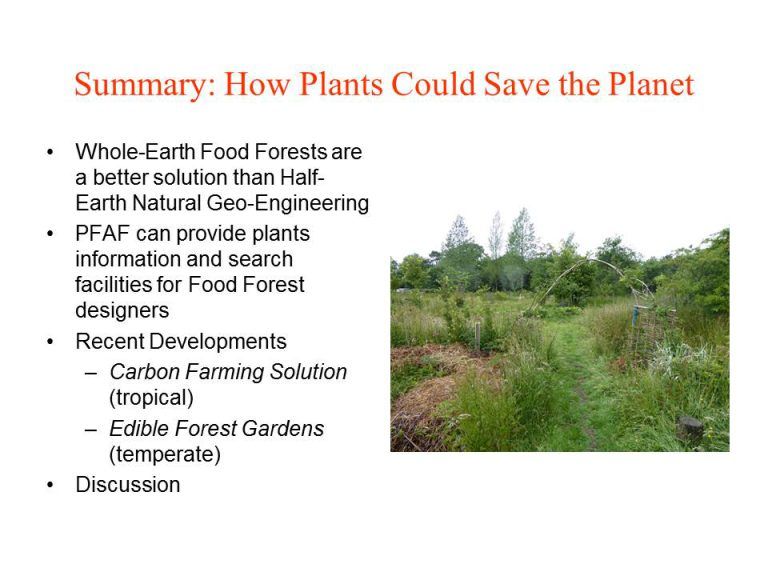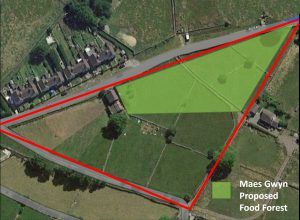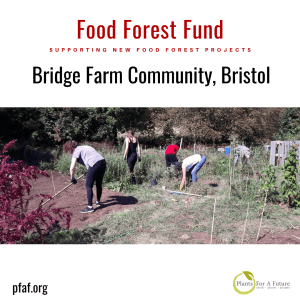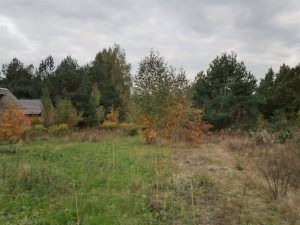The main role of (PFAF) for over 10 years has been to provide freely available non-commercial access to our database of over 8000 useful plants, for food, medicines and other uses. PFAF is very dependent on a flow of many small and a few larger donations from our users, with some revenue from sales of our books and advertising. This income does not cover our expenditure on maintenance and enhancement of the website and database, so we generally have an Appeal each year, focussed on publishing a new book or on a major development project. In 2019 we brought out a new book Edible Shrubs. We also continued work on a process we began three years ago, directed at aligning our database with strategies being implemented elsewhere for designing ‘carbon farming’ and ‘food forests’: agroecosystems of perennial plants. In particular, we have worked on a subset of the PFAF database made up of 1326 plants featuring in the species matrices in two important books: The Carbon Farming Solution: A Global Toolkit of Perennial Crops and Regenerative Agriculture Practices for Climate Change Mitigation and Food Security by Eric Toensmeier and Edible Forest Gardens: Ecological Design and Practice for Temperate Climate Permaculture by Dave Jacke.
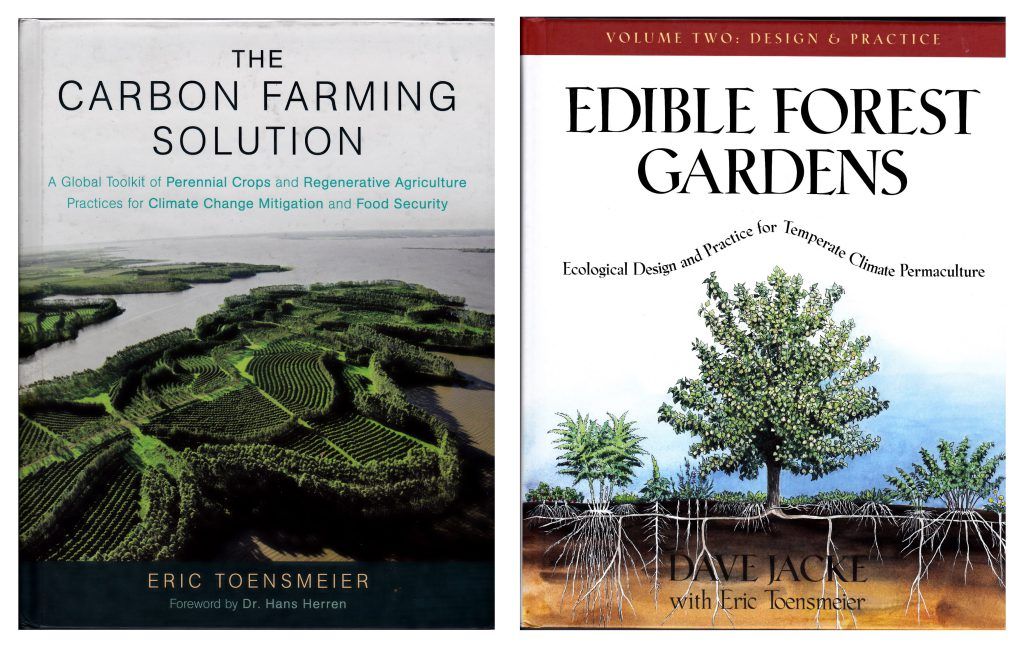
Toensmeier’s ‘Global Species Matrix’ has 700 tropical plants and Dave Jacke’s Species Matrix has 626 temperate plants. These are all present in the PFAF database so the current stage in the alignment work consists of adding ‘Carbon Farming’, ‘Food Forest’, ‘Carbon Sequestration’ and other relevant search items to those plant pages.
The next stage will be to promote and publicise this new resource for permaculture and other designers to help them make urgently needed radical and beneficial changes to the landscapes of the world. The case for such changes is presented in an earlier blog post on ‘Plants to Save the Planet’ (https://pfaf.org/plants/plants-to-save-the-planet/).
We know from website statistics that the majority of users of our database arrive from Google searches for particular plants. They then look through the details we provide for what they want to know and then move on. So, to begin the process of promoting the new resources for designers, it may be useful to provide some background to Plants For A Future with announcements of our 2019-20 Project. What follows is the slides and notes from a presentation entitled ‘Plants to Save the Planet’ given at the South West Permaculture Gathering in Plymouth.

We are all well aware that the planet is in crisis, with Climate Change, species extinctions and everything else. I’m going to suggest a utopian solution which is worth taking seriously – given the impending nightmare, anything is worth exploring.
The solution is to have Food Forests all over the world, at every scale from small family and community plots to farms. Here are 2 examples. The picture on the left is of Mandy Barber’s Incredible Vegetables one-acre site in Devon, where she grows an amazing variety of plants that yield food throughout the year, many of them perennials. She also carries out research into rare and special species like Nine-star broccoli.[1]
On the right is Mark Sheppard’s 106-acre New Forest Farm in Wisconsin, North America, a permaculture food forest, with 250,000 trees planted over 15 years, plus shrubs, vines, canes, perennial plants and fungi, planted in association to produce food, fuel, medicines and beauty.[2]
Very impressive and lovely, but can they save the world?

There are plenty of books on doom and gloom. The Uninhabitable Earth (this year) by David Wallace-Wells is terrifying.[3] The author says he’s optimistic, and puts his faith in carbon capture and storage and geo-engineering: cooling the planet by suspending gas in the atmosphere.[4]
Edward O. Wilson (2016) in Half-Earth: Our Planet’s Fight for Life,[5] has a better idea: natural geo-engineering rewilding and reforesting on a really big scale to draw down enough carbon to slow down – and even reverse – the global heating caused by burning fossil fuels. Wilson argues that to preserve biodiversity we have to dedicate half the surface of the Earth to nature. Humans would meet all our needs on the other half.
Rewilding is a positive idea but how long would it take? Reforesting needs people to plant all the trees and to tend them. But even if the new wilderness and forest areas become established, there is the risk of wildfires, which we’ve seen a lot of recently. As for restricting humans to half the land area, conventional agriculture is already causing serious land degradation, and intensifying agriculture would make that worse, and result in more carbon being released from the soil.
Whole Earth Food Forestry could be the answer. People would have to live in and amongst the forests, tending and harvesting – and putting out any fires that start. But the key challenge is designing food forests that are productive enough to feed everyone all the year round – and supply all our other needs and materials.
The Plants For A Future database at www.pfaf.org is potentially a valuable resource for Whole-Earth Food Forest designers. I hope we will discuss how feasible that is later, and how recent development work at PFAF might contribute to making it possible.
But before that, I’ll give a brief introduction to PFAF, the background and recent changes. Some of you will already know some of this so I’ll be brief.

PFAF is 30 years old this year.
There have been two stages and two concurrent operations.
From 1989 to the present there were Ken and Addy Fern on ‘The Field’, a 28 acre site in Cornwall, plus an online database.
Then from 2005 to the present there has been the PFAF Charity with 5 trustees in the UK and our database administrator in Australia.
First Ken and Addy Fern.

What Ken and Addy achieved was extraordinary.
Their 28 acre plants research site in Cornwall was degraded agricultural land on an exposed, sloping site. Their plan was to have half the land natural woodland, half diverse food forest. Over 10 years they planted 1,500 species of plants with edible & other uses. Ken became fascinated by the variety of useful plants for temperate situations, and to inform and encourage other plants enthusiasts, Ken set up a website and database with details of the 1,500 species he had grown and added details of other useful species.
A community of supporters gathered around the Ferns, and there were big plans for vegan-organic land sharing and eco-village development, but there were problems getting planning consent and other difficulties – an existential crisis, one might say (a long story & before my time) which led to the PFAF Charity taking over the running of the online database.

Since 2005 the Charity has maintained the free online service for plants enthusiasts worldwide.
We began by completely redesigning the website and database. As well as the ongoing process of checking and improvements, we have improved the search and research potential of the database.

This is an example of the sort of information provided in each plant entry of the database. One of the most important thing we’ve done is ensure that each plant has a photo or drawing for identification purposes.
In the last few years we have been thinking that it’s all very well to have an online plants encyclopaedia – and ours is by no means the only one – but it’s more important to know how to use plants together, as elements of designs, and for strategic reasons, to bring about deep changes in land use locally and worldwide, with the concept of Permanent Mixed Plantings.
So we have further developed the content and particularly the search facilities with land use designers more in mind.

Users can now search from over 8000 edible and medicinal plants using many search criteria – summarised on this slide. On the right is a screen shot of part of the search table. There are similar pages at the back of our books [hold one up] but using these facilities requires commitment, concentration and trial and error.
We know from website stats that there are about 2 million accesses a year, with users from every country of the world. But the majority arrive from a Google search on a particular plant, so they call up one plant page from the database and don’t look at the rest of the site. We moved the search facilities onto the home page to help with that.
Over the years we have published several books, using selected material from the plants database, which gave us different perspectives on the potential for the PFAF information resource. These are the most recent three:

Edible Trees, Edible Shrubs, and Edible Perennials make up the 3 main layers of Food Forests. [£16 paperback, £7.65 ebook] These sell well worldwide, both paperbacks and e-books.
Two years ago we realised that there is potential for our global reach. It came about from the publication of Eric Toensmeier’s book on Carbon Farming, that is ‘farming practices that sequester carbon’.

The full title shows that this is a serious global project: The Carbon Farming Solution: A Global Toolkit of Perennial Crops and Regenerative Agriculture Practices for Climate Change Mitigation and Food Security. Toensmeier is associated with Paul Hawken’s important Drawdown project.
So we decided to align our database with Toensmeier’s book, in particular with his Global Species Matrix of the most useful 700 plant species for Carbon Farming.
During 2017-18 we added 700 plants for tropical conditions to our database, ensuring that the database would include Toensmeier’s set and all the search terms of interest to Carbon Farming. It’s been a lot of work and we’ve had some grant funding to make it possible.
Building on that, we are now carrying out a similar exercise with Dave Jacke’s Edible Forest Gardens.

Unlike with the Global Species Matrix, we probably won’t need to add any new plants as we think we have all 626 temperate plants in Dave Jacke’s table in Edible Forest Gardens in the database.
What we will be doing is adding ‘Food Forest’ & other search terms to those plant pages.
We will also mark as ‘Food Forest’ all 700 tropical plants in the Carbon Farming matrix.
We will add icons to highlight plants which are good for Carbon Farming, Carbon Sequestration & Food Forest. We also plan to develop a facility for users to save a ‘favourites list’.
We are also looking at providing a product or service to provide a downloadable, local, site specific database, and we’ve carried out a survey amongst interested users to find out what they’d need.
So, to summarise:

We believe that Whole-Earth Food Forests are a better solution than Half-Earth Natural Geo-Engineering.
PFAF can provide plants information and search facilities for Food Forest designers and so we have aligned ourselves with Carbon Farming Solution with searchable details of 700 of the best tropical plants, and with Edible Forest Gardens with searchable details of 600 of the best temperate plants.
The picture is of Wenderlynn and Iain Bagnall’s Wishtree Agroforestry and Permaculture Centre in North Devon.
The big question is how all-the-year-round growing of mainly perennials could be encouraged around the UK and beyond.
I know there is much to discuss and these are a few topics that occurred to me.

These ideas and practices have not reached popular consciousness. Most people think of climate change in terms of protests like the recent Extinction Rebellion non-violent direct action and school strikes. They are demanding more urgent government policy change and public consultation.
The weakness of such protests is that they assume that governments are responsible for and are capable of finding and implementing solutions, and that governments can be goaded into action by the public. But governments have many other priorities and are subject to intensive lobbying by those with vested interests in business-as-usual.
But business-as-usual can be challenged by customers changing their buying patterns. For some years there have been Local Food movements around the world which have grown big enough to have economic clout.[6]
PFAF has been contributing to that movement for about twenty years by providing information on thousands of useful plants and enabling the sharing of experience of growing the plants in different situations. Progress towards whole-Earth food forestry extends that involvement into designs that are part of the solution to climate change.
That is why PFAF has moved in a new direction, away from an encyclopaedic coverage of useful plants towards a focus on Carbon Farming – tropical and temperate, aligning our information and search facilities with Toensmeier’s Global Species Matrix, Dave Jacke’s matrix from Edible Forest Gardens, and adding search terms for carbon farming and food forestry.
[1] https://www.incrediblevegetables.co.uk/
[2] Mark Shepard’s New Forest Farm which, in William Horvath’s opinion, is one of the best examples of a permaculture food forest. (https://permacultureapprentice.com/permaculture-profiles/new-forest-farm-mark-shepard-100-acre-15-years-of-establishment/ )
[3] David Wallace-Wells, The Uninhabitable Earth (London: Allen Lane, 2019)
[4] Wallace-Wells, p. 31.
[5] Edward O. Wilson, Half-Earth: Our Planet’s Fight For Life (New York: Liveright, 2016)
[6] Lester Brown, World on the Edge: How to Prevent Environmental and Economic Collapse (London: Earthscan, 2011), pp. 175-78.

